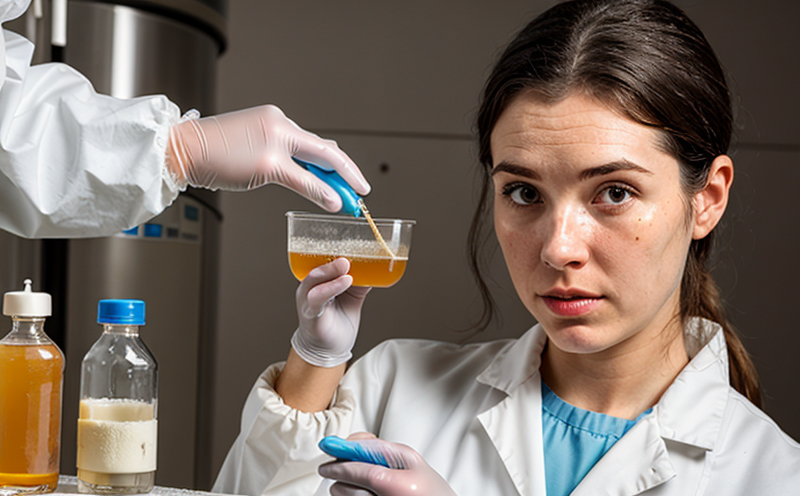FDA Mycological Analysis of Pharmaceutical Products
The FDA's mycological analysis ensures that pharmaceutical products are free from harmful molds, yeasts, and fungi. This process is critical in maintaining the safety and efficacy of drug formulations. In this section, we delve into the specifics of how our laboratory performs this analysis adhering to stringent standards.
Molds, yeasts, and fungi can compromise drug stability, alter product performance, and potentially cause allergic reactions or severe infections if present in therapeutic products. Our mycological analysis starts with the collection and preparation of samples which are then processed using advanced microscopy techniques. The goal is to identify any potential contaminants that could lead to adverse effects.
The process involves several key steps:
- Sample Collection: Gathering specimens from various stages in the production cycle, including raw materials, intermediates, final products, and packaging.
- Preparation: Ensuring samples are suitable for analysis by removing any non-microbial contaminants or additives that might interfere with identification.
- Microscopy Analysis: Utilizing light microscopy and sometimes scanning electron microscopy to visually identify fungal species present in the sample. This step is critical as it allows precise identification down to genus and species levels.
- Culture Methods: Employing agar-based culture techniques on selective media designed for different classes of fungi to confirm the presence or absence of contaminants.
- Identification: Using molecular biology methods such as PCR (Polymerase Chain Reaction) and sequencing to further verify fungal identities, especially when morphological examination is inconclusive.
Our laboratory adheres strictly to FDA guidelines which mandate that all pharmaceutical products must be free of any molds or yeasts unless proven otherwise. This includes ensuring compliance with ASTM, ISO, and other relevant international standards.
The importance of this analysis cannot be overstated, as it directly impacts public health. By conducting thorough and accurate mycological analyses, we help ensure that pharmaceutical products meet the highest safety and quality standards required by regulatory bodies like the FDA.
Applied Standards
The FDA requires all pharmaceutical companies to adhere to strict guidelines for ensuring product purity. Our laboratory follows these stringent requirements meticulously, using both national and international standards as benchmarks:
| Standard | Description | Purpose |
|---|---|---|
| FDA Guidance Documents | Provides comprehensive information on sampling, testing procedures and reporting. | To ensure consistency in methodology across all pharmaceutical companies. |
| ASTM E2146-18 | Standard practice for the identification of fungi from materials associated with health care facilities. | To standardize the methods used in identifying fungal contaminants, ensuring accurate and reliable results. |
| ISO 21587 | Guidelines for sampling and analysis of medicinal products to identify microorganisms. | To provide a global standard for the sampling and analytical methods used in pharmaceutical testing, ensuring uniformity across different countries and regions. |
These standards are crucial in maintaining consistency and reliability in our analyses. By adhering to them, we ensure that every test conducted is accurate and meets regulatory expectations.
Industry Applications
The FDA mycological analysis has numerous applications within the pharmaceutical industry. It is particularly important for ensuring the safety of products during development, manufacturing, and distribution stages. Here are some key areas where this service finds application:
- Development Stage: Ensuring that experimental drugs do not contain harmful microorganisms before they enter clinical trials.
- Manufacturing Process: Monitoring the production environment to identify any potential sources of contamination, allowing for timely corrective actions.
- Distribution and Storage: Checking packaged products at various stages to ensure that no new contaminants have been introduced during transport or storage.
In addition, this analysis is also vital for ensuring compliance with Good Manufacturing Practices (GMP) guidelines issued by the FDA. By adhering to these practices, we help pharmaceutical companies maintain the highest standards of quality and safety in their products.
Use Cases and Application Examples
| Use Case | Description | Application Example |
|---|---|---|
| Contamination Prevention | Detecting early signs of fungal contamination in raw materials. | A pharmaceutical company identified a batch of active ingredients contaminated with Aspergillus flavus during the initial stages of production. Early detection allowed for the replacement of affected batches and prevented potential product recalls. |
| Quality Assurance | Ensuring that final products are free from any fungal contaminants. | A large-scale manufacturer conducted regular mycological analyses on their finished product line to ensure consistent quality. This helped in maintaining the reputation for reliability and safety among consumers. |
| Safety Checks | Verifying that packaging materials do not introduce new strains of fungi into products. | During a routine check, a packaging company discovered that their newly procured paper labels were contaminated with Penicillium species. Immediate action was taken to replace the material and prevent its use in production. |
| Environmental Monitoring | Identifying environmental conditions conducive to fungal growth within manufacturing facilities. | A biotech firm found that certain areas of their plant had high humidity levels, which led to increased fungal activity. Addressing these issues through improved ventilation significantly reduced the risk of contamination in subsequent batches. |
These examples highlight how mycological analysis plays a crucial role in maintaining product safety and quality across various stages of pharmaceutical production.





